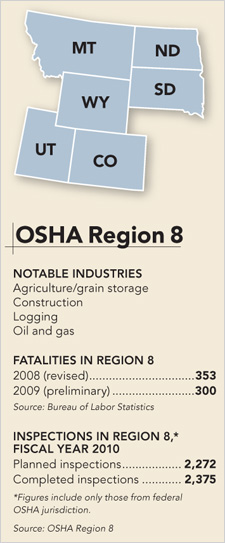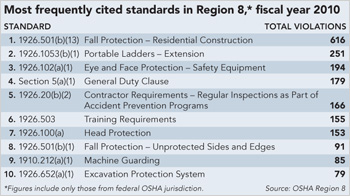Looking to the future
In the face of challenges and tragedy, OSHA Region 8 envisions cooperation, changing cultures and better educated workers
By Kyle W. Morrison, senior associate editor
Greg Baxter envisions many changes awaiting OSHA Region 8 in the future.
As the regional administrator in charge of OSHA activity in Colorado, Montana, North Dakota, South Dakota, Utah and Wyoming, Baxter recognizes the changes that must occur to face some of the mountainous challenges his region faces. Some of those changes are the result of financial constraints and a need to be more economical, while others are the result of tragedy and a desire to stem future ones.
Fewer offices, more reach
 One of Region 8’s great challenges is geography. Region 8 is spread out over a vast area, making it difficult for inspectors to easily travel to different jobsites. As Baxter explained it, a compliance officer often cannot drive to an inspection site – he or she has to fly.
One of Region 8’s great challenges is geography. Region 8 is spread out over a vast area, making it difficult for inspectors to easily travel to different jobsites. As Baxter explained it, a compliance officer often cannot drive to an inspection site – he or she has to fly.
Inspectors are based at only a few area offices. In fact, South Dakota has no OSHA area office (although it does have an onsite consultation office). A proposed office in Sioux Falls, SD, likely will not be created because of budgetary constraints.
Instead of additional offices, Baxter envisions telecommuting, which would allow inspectors to be based in areas across the region without an agency office. Despite difficulties with this approach, Baxter believes telecommuting is the best way to place inspectors throughout the region.
“You’ve got to give them the right capabilities, the right equipment and the right training, but I believe you can do it and you will be doing it,” he said, adding that an area office is not where a compliance officer’s impact is. “The place they’re going to make a difference is in the workplace,” he said.
Mexico partnership
Another challenge Region 8 is working to resolve involves work-related injuries among the Hispanic population. Several years ago, Region 8 had an alliance with the Mexican consulate in Denver to better provide safety education for Hispanic workers.
The hope is to educate the consulate and its workers on understanding OSHA and employers’ responsibilities, and defining worker rights so the consulate can act as a conduit for OSHA’s message.
“They’re afraid to talk to the federal government, and this is an intermediary,” Baxter said of some members of the Hispanic population. “They can talk to the consulate and the consulate can give help.”
An alliance also could bring back another successful method of spreading OSHA’s message to hard-to-reach workers – the “mobile consulate.” During the previous alliance, OSHA joined consulate officials as they traveled to various locations for outreach. The agency believed that because the events were sponsored by the consulate and not the U.S government, more people were likely to attend and OSHA was better able to provide technical assistance and information on the agency.
Helping the youth
Teens entering the workforce are some of the most vulnerable workers, and recent events showcase the tragedy that can befall young employees. In 2009, a teen worker for Tempel Grain Elevators in Wiley, CO, suffocated after being engulfed by grain in one of the facility’s bins.
 “In this day and age, it just doesn’t seem right that we should have that type of fatality,” Baxter said.
“In this day and age, it just doesn’t seem right that we should have that type of fatality,” Baxter said.
The incident, and similar incidents throughout the country, eventually led to a nationwide campaign to educate grain facility operators on engulfment dangers and labor laws concerning children.
Young workers are a major focus for Region 8. Every year, Construction Career Days takes place in the Denver area, with as many as 1,500 high school students attending to learn about the construction industry. Contractors bring in equipment, and students have the opportunity to build brick walls and work on sheet metal.
OSHA attends the event to provide assistance to the children and offer safety and helath training “You try to get them to start identifying the common things … that can happen to you and what you can do to correct them,” Baxter said. “If you can get them coming in to the workplace early thinking about safety and health, it benefits everybody.”
Post a comment to this article
Safety+Health welcomes comments that promote respectful dialogue. Please stay on topic. Comments that contain personal attacks, profanity or abusive language – or those aggressively promoting products or services – will be removed. We reserve the right to determine which comments violate our comment policy. (Anonymous comments are welcome; merely skip the “name” field in the comment box. An email address is required but will not be included with your comment.)

